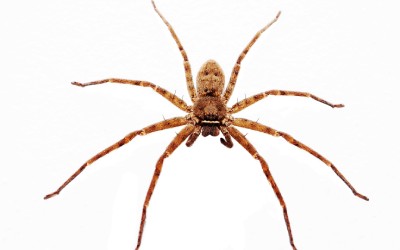Imagine this: you’re walking to the kitchen to get a late-night snack when you find a spider in the middle of the floor. It’s not one of those benign Daddy Long Legs – it’s big and dark and roughly the length of a Twinkie. Your brain goes into autopilot, and you run to grab your nearest and heaviest shoe. It’s worked for other bugs, hasn’t it? That’s what you keep telling yourself as you approach the spider and slam your boot over it. That should be the end, but you’re suddenly horrified to find a rippling wave of tiny spiders rushing out from underneath your shoe. There are hundreds of them, all moving frantically in different directions and gradually taking over your kitchen.
Yes, this is a horror story just in time for Halloween. It’s also a very real possibility if you cross paths with a wolf spider and react without thinking. If you take a moment to stop and look over the bug that has invaded your home, you can avoid casting yourself in a one-person scary movie. Inman-Murphy can help residents of the Memphis metro area make sure the only creepy spiders in their home are Halloween decorations.
Identifying the Wolf Spider
Wolf spiders are often mistaken for other, more dangerous spiders, mainly the black widow and brown recluse. They all have two body parts (the cephalothorax and abdomen) and large, fang-like chelicerae. What separates them in many cases is the size – brown recluses are about the size of a quarter, while wolf spiders can be three, sometimes even four inches depending on the region they’re found in. Wolf spiders are also one of the only members of its species that don’t live on a web. Instead, they run to catch their prey with a staggering gait of two feet a second. That’s how they manage to catch and eat larger insects and other, smaller spiders.
The most distinctive quality of the wolf spider, though, would have to be how the female carries her young. There is no web to store her eggs, so instead, she moves about the environment with her egg sac on her abdomen. Once they hatch the babies stay in their makeshift carriage, so at nearly any point in time the mother wolf spider has hundreds of spiderlings hanging on her wherever she goes. So if some unsuspecting passer-by gets a fright and disturbs or tries to squish the mother, the babies will scatter in all directions. Not a fun sight for anyone, so what can you do to keep from ending up in that person’s unfortunate, spider-covered shoes?
DIY Spider Control Strategies
Spiders are inevitable living around Tennessee, but there are things you can do to control the access these eight-legged nuisances have to your home. Some of these tips are things that are good to do anyway, like sweeping and vacuuming on a regular basis and keeping closets and other undisturbed places free of clutter. Because all spiders – wolf spiders included – like little nooks where they can sit and wait for their next meal. In that same vein, we also advise moving any firewood or other piles of debris away from the exterior of your house, as well as trimming low-hanging branches or anything else that a spider can use as direct access to your home.
These are all easy precautions to take, but if you do all that and still find yourself running a “Mommy and Me” for wolf spiders and their many, many children, Inman-Murphy can help!
Spider Control with Inman-Murphy
Halloween is a great time to go out and get scared, but when you get home you want a place you can consider safe and free of any giant spiders. Home remedies can be useful in spider prevention, but there comes a time when you need professional help. Inman-Murphy has expertise in long-term spider control. A happy ending for your no-longer horror movie. To get a free quote, contact us today!

